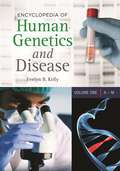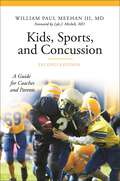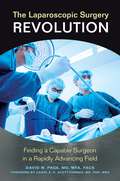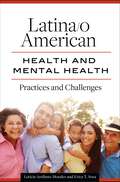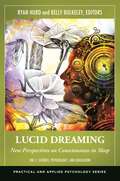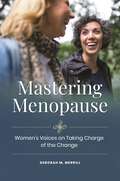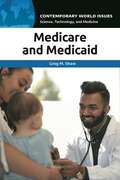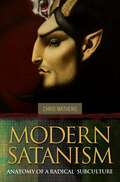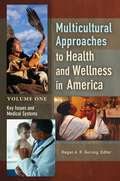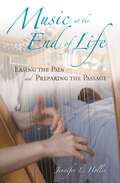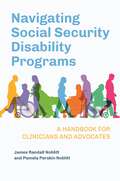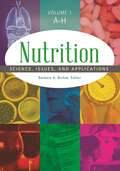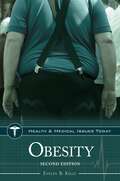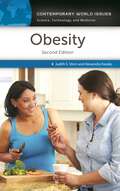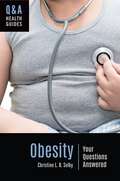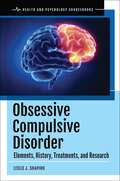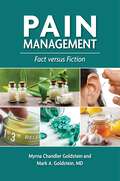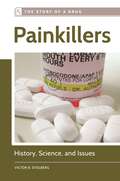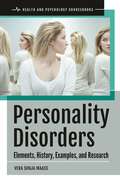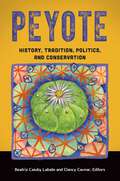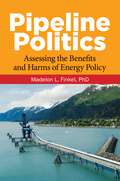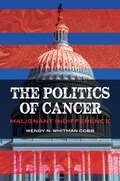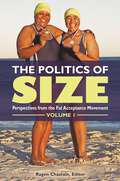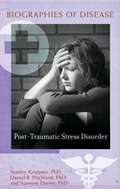- Table View
- List View
Encyclopedia of Human Genetics and Disease [2 volumes]: [2 volumes]
by Evelyn B. KellyThis two-volume encyclopedia examines the history, characteristics, causes, and treatment of genetic disease, as well as the science of genetics itself.Modern science has unlocked many of the mysteries of genetics, providing a blueprint for understanding the origins behind previously mysterious ailments and conditions, both common and uncommon. A complete understanding remains elusive, however: geneticists are still refining theories about what causes chromosomes to mutate, and genetic diseases remain difficult to diagnose and challenging to treat. This fascinating reference explores the scientific and human aspects of this complex field of science.Encyclopedia of Human Genetics and Disease features nearly 400 entries, including well-known genetic diseases, rare and lesser-known genetic diseases, and the genetic factors that may contribute to common diseases and health conditions, such as breast cancer and obesity. The author presents in-depth discussions of concepts essential to understanding genetic disease in 18 entries that provide background on key topics, such as "Genetics 101," the genome and the foundations of genetics, genetic counseling, and newborn screening. Each of the 355 disorders profiled provides the history of the condition, its prevalence, causes, treatment (if any), and further reading. Interesting sidebars and compelling photos that help inform content accompany many entries.
Kids, Sports, and Concussion: A Guide for Coaches and Parents (The Praeger Series on Contemporary Health and Living)
by William Paul IIIA comprehensive summary of sport-related concussion for parents, coaches, and athletes that considers the physics behind the injury, identifies what can be done to reduce the risk of its occurrence, and describes how to respond to a suspected concussion.Concussion injury among athletes continues to be a subject of great concern. Increasing attention and research is focusing on the most vulnerable of athletes—children. What strategies can be taken to best protect young athletes in sports from grammar school football leagues to high school hockey and soccer teams from concussion? How do we treat youngsters who suffer head injuries in sports? What are the ethical considerations in allowing children to play such sports, given the risks to still-developing brains? In this updated and expanded guide, William Meehan, MD, explains simply and clearly how coaches, parents, and others who work with young athletes can recognize concussion; best help children and youths recover from concussion injuries; and take steps to become proactive to prevent concussion. Readers will learn what causes a sport-related concussion; what happens to brain cells during a concussion; and why concussion, which in the past was dismissed as a trivial injury, is taken so much more seriously now. The book explains how to decrease the risk of concussion; addresses the potential for cumulative effects from multiple concussions, including chronic traumatic encephalopathy; and discusses the ethical dimensions of deciding whether an athlete with multiple concussions should continue to participate in high-risk sports.
The Laparoscopic Surgery Revolution: Finding a Capable Surgeon in a Rapidly Advancing Field
by David W. MDWritten by a surgeon with 40 years' experience in practice and instruction, this book provides vital, up-to-date information that explains the strengths and weaknesses of the laparoscopic surgery field to enable potential surgical patients to make the best decisions and choose a surgeon wisely.More than 30 years ago, laparoscopic or "keyhole" surgery suddenly appeared as an operative technique. Laparoscopy quickly grew in the U.S. surgical field, where now more than two million operations annually use the technique. But is the training surgeons receive in laparoscopy sufficient to ensure patient safety? What are the specific situations where laparoscopy is beneficial and justified, and when is it ill-advised due to the additional complexity and risk factors? This is the first book written for general readers—avoiding medical jargon wherever possible—to expose the gritty history and downsides of "minimally invasive surgery." Additionally, it provides the perspective and insights of an esteemed surgeon who was working at the inception of laparoscopy and has a full understanding of this now widely popular procedure across its development and lifespan.Readers will learn about the emergence of laparoscopic techniques in the 1990s, understand how minimally invasive surgery has been a boon to the business of surgery and to patient health and recovery overall, appreciate how the complexity involved in laparoscopic surgery has led to a higher incidence of surgeon "incompetence," and grasp the responsibility of a patient to take steps to assure that the surgeon is qualified before going into the operating room. Examination of eye-opening statistics on the outcomes of laparoscopic procedures documents the high level of capability of most surgeons, as well as the lack of appropriate ability with certain laparoscopic operations in the hands of some surgeons. The author also spells out how informed patients can be prepared to discuss and consider all aspects of an operation—and the surgeon's training and experience—to assure the best outcome for their health.
Latina/o American Health and Mental Health: Practices and Challenges (Race, Ethnicity, Culture, and Health)
by Leticia Arellano-Morales Ph.D. Erica T. SosaEssential reading for health and mental health administrators, community agencies, and policy makers as well as students and general interest readers, this book details the state of the physical and mental health of many Latina/o American groups.While Latina/o Americans originate from more than 25 countries, most health or mental health texts largely focus on Mexican Americans and often fail to address other Latina/o groups, such as South Americans, Central Americans, Puerto Ricans, and others. Moreover, most works address either health or mental health, but not both together. In contrast, Latina/o American Health and Mental Health addresses both the health and mental health of diverse Latina/o heritage groups. An interdisciplinary approach enables readers to identify both similar and divergent areas that affect the health and mental health of Latina/o Americans. Strengths-based and social justice perspectives, rather than a deficit perspective, guide the work in its assessment of disparities among treatment for different groups.This text is ideal for graduate students, practitioners, researchers, and policy makers in public health, community health, family studies, psychology, counseling, social work, and Latina/o studies who are interested in understanding Latina/o health and mental health in the United States and providing culturally responsive services.
Lucid Dreaming [2 volumes]: New Perspectives on Consciousness in Sleep [2 volumes] (Practical and Applied Psychology)
by Ryan Hurd Kelly Bulkeley Jorge Conesa-Sevilla Daniel Erlacher Jayne Gackenbach Brigitte Holzinger David J. Hufford Harry T. Hunt Lee Irwin Stephen Laberge James F. Pagel Tim Post G. Scott Sparrow Tadas Stumbrys Isaac Y. Taitz Georg Voss Ursula Voss Robert Waggoner Mary ZiemerIn this fascinating new collection, an all-star team of researchers explores lucid dreaming not only as consciousness during sleep but also as a powerful ability cultivated by artists, scientists, and shamans alike to achieve a variety of purposes and outcomes in the dream.The first set of its kind, Lucid Dreaming: New Perspectives on Consciousness in Sleep provides a comprehensive showcase of the theories, research, and direct experience that serve to illuminate how certain people can maintain conscious awareness while dreaming. The text is organized into two sections, covering science, psychology, and education; and religious traditions, creativity, and culture. Contributors to this two-volume work include top dream experts across the globe—scholars sharing knowledge gained from deep personal explorations and cutting-edge scientific investigations.Topics covered include the neuroscience of lucid dreaming, clinical uses of lucid dreaming in treating trauma, the secret history of lucid dreaming in English philosophy, and spiritual practices of lucid dreaming in Islam, Buddhism, and shamanic traditions. The work also addresses lucid dreaming in movies including The Matrix and literature such as the fiction of J.R.R. Tolkien and explains how modern video gaming enhances lucidity. This set serves as an ideal text and reference work for school libraries and academic courses in anthropology, psychology, religious studies, and cognitive science as well as for graduate-level study in holistic education—an increasingly popular specialization.
Mastering Menopause: Women's Voices on Taking Charge of the Change
by Deborah M. MerrillInterviews with and case studies of women in the U.S., accompanied by research in this text, show how our perceptions, thoughts, and spiritual practices can help women through menopause without drugs and their potential side effects.More and more women today are seeking natural ways to cope with menopause, including through mindfulness techniques and Eastern practices such as meditation. Women of various races, ages, and socioeconomic status interviewed at length for this study explain their experiences, victories, and setbacks in their quests to overcome this natural but body- and brain-altering change. Complementing findings from her research with wider outside research, author Deborah Merrill explains how popular culture depictions, race, class, and education all alter women's perceptions of the meaning of menopause, and how those perceptions can complicate, exacerbate, or alleviate physical and psychological symptoms. She details the "medical view" that views menopause as a problem to be solved, rather than as a natural event. And, through women's words and case studies, she details psychospiritual approaches many are adopting to cope, instead of seeking potentially harmful medicines. Readers will find new insights, wisdom, and potential solutions in the array of voices, experiences, and paths taken and presented in this book.
Medicare and Medicaid: A Reference Handbook (Contemporary World Issues)
by Greg M. ShawMedicare and Medicaid: A Reference Handbook provides an in-depth discussion of these two large government health insurance programs. It additionally addresses such related issues as health care, government spending, and socialized medicine.Many Americans hold conflicting views on how to pay for health care. They fear that government involvement will either undermine the quality of care or cost taxpayers too much. However, over the past half-century, hundreds of millions of Americans have come to rely on government health insurance because they are elderly, low-income, or both.Medicare and Medicaid: A Reference Handbook provides high school and college readers with a one-stop resource on these two government insurance programs. A background and history of the topic are followed by a chapter on problems, controversies, and solutions. Perspectives and profiles speak to current program strengths, political concerns, and problems. There is a strong focus on current program challenges and opportunities.Moreover, most of the government documents referenced in a dedicated resources chapter are produced periodically, with updates accessible online, so the book should enjoy an enduring shelf-life. The volume closes with a glossary and bibliography.
Mindfulness and Meditation: Your Questions Answered (Q&A Health Guides)
by Blaise AguirreThis book is an approachable introduction to the topics of mindfulness and meditation as they relate to teens and young adults. The information, guidance, and resources offered make it a valuable tool for anyone curious about this trending topic.Although mindfulness and meditation have been practiced for millennia, modern neurobiologists and psychologists are only just beginning to understand their full potential for improving physical and emotional well-being. Part of Greenwood's Q&A Health Guides series, Mindfulness and Meditation: Your Questions Answered provides clear, concise information for readers interested in the contemporary practice of, and research behind, mindfulness and meditation. It explores definitions of mindfulness and meditation, offers solutions for successfully incorporating them into our often-chaotic lives, and explains their many practical applications and benefits for practitioners. Each book in this series follows a reader-friendly question-and-answer format that anticipates readers' needs and concerns. Prevalent myths and misconceptions are identified and dispelled, and a collection of case studies illustrates key concepts and issues through relatable stories and insightful recommendations. The book also includes a section on health literacy, equipping teens and young adults with practical tools and strategies for finding, evaluating, and using credible sources of health information both on and off the Internet—important skills that contribute to a lifetime of healthy decision-making.
Modern Satanism: Anatomy of a Radical Subculture
by Chris MathewsIn 1966, Anton LaVey introduced to the world the Church of Satan, an atheistic religion devoted to the philosophy of individualism and pitilessness often associated with Satan. Modern Satanism offers a comprehensive survey and analysis of the church that LaVey built. Satanism has been an open religion for forty years now and operates successfully in its self-created countercultural niche. Given the provocative nature of its name, contemporary Satanism is only superficially understood as an alternative religion/ideology, and all-too-frequently seen as a medieval superstition and associated with rumors of obscure rituals, perverse hedonism, cult-like behavior, and tales of ritual abuse and murder. These may be misconceptions, but the truth behind the unenviable reputation is no less dramatic. Satanism generally eschews supernatural beliefs and embodies a staunchly individualistic, pitiless, anti-egalitarian creed. If there is anything fundamentally diabolical about modern Satanism, it stems more from the echoes of Nazism in its theories than from its horror-comic trappings.Modern Satanism covers the history, ideology, personalities, and practices of the decentralized international movement that contemporary Satanism has become. The work addresses the various beliefs and practices espoused by those who follow it: the ideal of Satan as a rebellious emblem; Satanism's occult, literary, and philosophical influences; the history of the Church of Satan and other Satanic organizations; the ideology of Satanism; Satanism's frequent flirtations and strong parallels with neo-Nazism and other forms of extremism; Satanism in the media and popular culture; and the reasons for Satanism's continuing attractiveness to new converts. Though the tone of the work attempts to remain neutral when discussing historical matters, it is by necessity critical of the subculture's extremist rhetoric and recurring associations with the far right and racialist extremism.
Multicultural Approaches to Health and Wellness in America [2 volumes]: [2 volumes]
by Regan A. R. GurungLed by a UCLA-trained health psychologist, a team of experts describes non-traditional treatments that are quickly becoming more common in Western society, documenting cultural variations in health and sickness practices to underscore the diversity among human society.This unique two-volume set describes the variety of cultural approaches to health practiced by people of varying cultural heritages and places them in stark context with traditional Western approaches to health care and medicine. Examining health practices such as Ayurveda, an ancient system of medicine that focuses on the body, the sense organs, the mind, and the soul; and traditional Chinese medicine (TCM), the author examines why these different approaches can explain some of the cultural variations in health behaviors, differences in why people get sick, and how they cope with illness. Traditional health care providers of all kinds—including clinicians, counselors, doctors, nurses, and social workers—will all greatly benefit by learning about vastly different approaches to health, while general readers and scholars alike will gain insight into the rich diversity of world culture and find the material fascinating.
Music at the End of Life: Easing the Pain and Preparing the Passage (Religion, Health, and Healing)
by Jennifer L. HollisA practicing music thanatologist provides an insider's history of this remarkable profession, which combines music, medicine, and spirituality to help the terminally ill and their families face the end of life.Reflecting on the author's experiences as a music-thanatologist, Jennifer Hollis's Music at the End of Life: Easing the Pain and Preparing the Passage is an enlightening and emotional examination of the ways in which the experience of dying can be transformed with music.Music at the End of Life highlights the unique role music has come to play in hospice and palliative medicine. Jennifer Hollis interweaves narrative memoir, the personal experiences of fellow music-thanatologists and caregivers, and extensive research to demonstrate the transformative power of music when curing is no longer an option. Through story after unforgettable story, Hollis offers a new vision of end-of-life care, in which music creates a beautiful space for the work of letting go, grieving, and saying goodbye.
Navigating Social Security Disability Programs: A Handbook for Clinicians and Advocates
by James Randall Noblitt Pamela Perskin NoblittThis book responds to a previously unmet need: unlocking the mysteries of Social Security disability programs and providing medical and mental health clinicians, as well as advocates, with the information necessary to act in the best interests of their clients.This text aims to bring clarity to medical and psychological health care providers so they better understand the importance of their role in disability determinations by familiarizing them with the benefits, limitations, and qualifications for Social Security Disability Insurance and Supplemental Security Income. Also useful for patient advocates, the authors here provide insights into the workings of Social Security, the language employed, the definitions adhered to, and the reliance on providers to respond to requests from Social Security and their patients to support their claims when warranted. Almost all medical and mental health professionals will need to interact with Social Security at some point, but will not understand the relevance or importance of their response. Much hangs on the clarity of treatment notes and opinions rendered by clinicians. Not only can their failure to respond to requests for Social Security, or to their patients in a disability case, obstruct their patients' access to benefits, it may also put a provider at risk of board censure or civil suit.
Nutrition [2 volumes]: Science, Issues, and Applications [2 volumes]
by Barbara A. Brehm, EditorThis thorough one-stop resource draws on solid science and the latest research to play a dual educational role—providing background for students while answering general readers' questions about a wide range of nutrition-related topics.Nutrition is a popular but often misunderstood topic, one about which there is a great deal of interest as evidenced by the plethora of available advice. Because nutrition is a key factor in health, it is important that the public have a source of information they can trust. This is that source: a comprehensive overview that will help readers make sense of conflicting information they find in the media regarding what is healthy and what is not. Organized alphabetically, the two-volume work covers the most important topics in human nutrition including nutrients, nutrition-related health concerns, aging and nutrition, eating disorders, and the value of dietary supplements. The digestive system and its organs are discussed, with particular attention to health issues such as irritable bowel syndrome and the role of helpful bacteria. The physiology of hunger and the psychology of appetite and eating behaviors are explained. The work also delves into data on foods that have been featured in recent research, such as garlic, ginger, and turmeric, and it offers consumers a clearer understanding of nutrition-related practices such as organic farming, genetically modified foods, and the use of food additives.
Obesity (Health and Medical Issues Today)
by Evelyn B. KellyThis book explores what obesity is, its causes and implications for health, and the many issues and controversies surrounding it, both in the medical community and within society as a whole.Obesity is defined as the state of having a body mass index (BMI) greater than 30. Although it may be easy to identify what obesity is, however, identifying its causes and effects can be more challenging. Genetic, hormonal, environmental, and behavioral factors all play a role in defining our weight, and the consequences of obesity go far beyond medical complications, to include impacts on psychological well-being and social health, and how we think about and address this growing epidemic has become just as controversial as it is important.This second edition of Obesity offers a wealth of new information and features. Coverage of genetic and hormonal causes of obesity has been greatly expanded, as has discussion of medications and surgical techniques to manage obesity. The book reflects our expanded scientific understanding of obesity and delves into medical and societal debates about weight that have emerged in recent years. Also new in this edition is a collection of case studies, each of which helps to make the topics discussed in the book more accessible to readers.
Obesity: A Reference Handbook (Contemporary World Issues)
by Judith S. Stern Alexandra KazaksObesity has reached epidemic proportions in countries like the United States. This book provides a comprehensive summary of obesity in America and around the world, discussing the causes and proposing ways to help stem the tide and to help those who are overweight.A highly useful and accessible resource for high school to undergraduate students as well as post-graduate level readers with an interest in health and nutrition, this updated second edition of Obesity: A Reference Handbook offers up-to-date answers to essential questions about obesity and connected societal and health care-related issues. A single-volume, go-to resource, this book addresses difficult questions such as whether obesity is a disease or a moral failing; what factors contribute to obesity; what the economic impacts of obesity are on the health care industry; if and how poverty is a contributor to obesity; how our society encourages obesity; and how changes can be made to improve our society's eating habits as a whole. It presents citations from individuals and peer-reviewed journals and review articles, providing a balance of information sourced from both professionals and informed lay commentators. Also included are dozens of biographies of individuals who have been important in studying, preventing, managing, or increasing awareness about obesity, such as Jared Fogle, longtime Subway sandwiches spokesperson; Kelly Brownell, who coined the phrase "toxic environment" to describe unhealthy food and exercise patterns; researcher Ethan Allen Sims, who examined the relationship between obesity and diabetes; and Oprah Winfrey, well-known celebrity who stated that if there were a pill to lose weight or a magic diet, she would have it.
Obesity: Your Questions Answered (Q&A Health Guides)
by Christine L. SelbyThis book serves as an accessible resource for teens who want to learn more about obesity. The information and guidance it offers make it a valuable tool for young adult readers with questions or concerns about their weight.Obesity—represented by a BMI over 30—may be easy to define, but its causes and consequences and how individuals and agencies should address it are not as clear. Is obesity simply the result of eating more calories than one burns, or are other factors involved? Can an individual be obese and healthy? How does obesity affect psychological and social health? Are public health campaigns targeted at reducing obesity helping or hurting? Obesity: Your Questions Answered, a part of Greenwood's Q&A Health Guides series, answers these and other questions related to this high-interest topic. Each book in this series follows a reader-friendly question-and-answer format that anticipates readers' needs and concerns. Prevalent myths and misconceptions are identified and dispelled, and a collection of case studies illustrates key concepts and issues through relatable stories and insightful recommendations. The book also includes a section on health literacy, equipping teens and young adults with practical tools and strategies for finding, evaluating, and using credible sources of health information both on and off the internet—important skills that contribute to a lifetime of healthy decision-making.
Obsessive Compulsive Disorder: Elements, History, Treatments, and Research (Health and Psychology Sourcebooks)
by Leslie J. ShapiroA comprehensive introduction to one of the most common psychiatric disorders, a condition that results in intrusive, irrational thoughts and/or repetitive, illogical physical or mental actions.Titles in this Health and Psychology Sourcebooks series address psychological, physical, or environmental conditions that threaten human health and wellbeing. This book presents a comprehensive overview of OCD—one of the five most common psychiatric disorders. Obsessions range from those associated with contamination, safety, and order or symmetry to scrupulosity, or the need the do the "right" thing. Compulsions range from counting, touching, and tapping to excessive cleaning/washing, arranging, or even hoarding. Written by a therapist among the most experienced in the world in dealing with this disorder, this book covers the incidence, symptoms, diagnosis, history, development, and causes, as well as the effects and costs of OCD. It also addresses theory, research, and treatments and offers insight into and case studies illustrating how the disorder displays in society, at work, and in relationships. A glossary of terms, suggested further readings, and resource websites and organizations listing are included.
Pain Management: Fact versus Fiction
by Myrna Chandler Goldstein Mark A. MDThis accessibly written book examines the most commonly used substances and techniques for managing pain, exploring why they work (or don't), their risks and benefits, and key research findings regarding their use.No one is a stranger to pain. From sudden injuries to post-operative discomfort to nagging aches and stiffness, pain is an unwelcome but familiar part of life. There are numerous methods for managing pain, but it can be difficult to know which is the best fit and to separate truth from hype.Pain Management: Fact versus Fiction examines 30 well-known options for combating pain, whether acute or chronic. Utilizing a standardized structure, each entry discusses a particular substance or technique's origins and underlying principles, how and in what context it's used, and its advantages and disadvantages. Summaries of key research studies are included to help readers better determine which treatments may be a good choice for them. Introductory materials give readers a foundational understanding of what pain is, how it's categorized and measured, and the impact it can have on individualS&Rsquo; physical and psychological well-being. A Further Reading section at the end of each entry points readers toward additional resources to expand and deepen their knowledge.
Painkillers: History, Science, and Issues (The Story of a Drug)
by Victor B. StolbergThis accessible, easy-to-read book provides readers with different perspectives on the subject of painkillers, examining their history, production, uses, and dangers.Many different drugs are effectively used as painkillers—substances that greatly improve the quality of life for those who suffer from temporary or recurring pain. This book presents an in-depth overview of opiates, opioids, and other painkilling substances such as non-steroidal anti-inflammatory drugs (NSAIDs) that have been in use from ancient times up to the contemporary era. It also addresses the risks of painkiller use, their misuse, and potential overdose concerns.The latest in the Story of a Drug series and written by a subject expert who has published widely on drug use and pharmacology, this book presents a brief review of the science of how different painkiller drugs work before covering these substances' respective effects and applications; the issues regarding the production, distribution, and regulation of painkiller drugs; and research findings on painkiller use, abuse patterns, addiction, and policy issues. The easy-to-understand text presents scientifically accurate information that enables readers to better understand the key role of painkillers in our 21st-century world.
Personality Disorders: Elements, History, Examples, and Research (Health and Psychology Sourcebooks)
by Vera Sonja MaassDetails each of the 10 personality disorders, in a format that makes locating information easy.Personality Disorders systematically explores 10 personality disorders. Each chapter presents a comprehensive and in-depth picture of a particular disorder and its effects, not only on those who suffer from it but also on family, friends, and colleagues as well as the community at large. Chapters focus on important parameters such as symptoms, diagnosis, incidence, history, development, causes, effects, and costs. Relevant case histories and Up Close sections illustrate how the disorder may manifest in different environments and reveal how the disorder can affect a person's interactions within society, at work, and in personal relationships. Research and theories about each particular disorder are also included. Every chapter closes with a discussion of various treatment approaches and a brief list of references, providing for a meaningful presentation for readers at the undergraduate student level and beyond.
Peyote: History, Tradition, Politics, and Conservation
by Beatriz Caiuby Labate and Clancy CavnarThis book explains the role that peyote—a hallucinogenic cactus—plays in the religious and spiritual fulfillment of certain peoples in the United States and Mexico, and examines pressing issues concerning the regulation and conservation of peyote as well as issues of indigenous and religious rights.Why is mescaline—an internationally controlled substance derived from peyote—given exemptions for religious use by indigenous groups in Mexico, and by the pan-indigenous Native American Church in the United States and Canada? What are the intersections of peyote use, constitutional law, and religious freedom? And why are natural populations of peyote in decline—so much so that in Mexico, peyote is considered a species needing "special protection"? This fascinating book addresses these questions and many more. It also examines the delicate relationship between "the needs of the plant" as a species and "the needs of man" to consume the species for spiritual purposes.The authors of this work integrate the history of peyote regulation in the United States and the special "trust responsibility" relationship between the American Indians and the government into their broad examination of peyote, a hallucinogenic cactus containing mescaline that grows naturally in Mexico and southern Texas. The book's chapters document how when it comes to peyote, multiple stakeholders' interests are in conflict—as is often the case with issues that involve ethnic identity, religion, constitutional interpretation, and conservation. The expansion of peyote traditions also serves as a foundation for examining issues of international human rights law and protections for religious freedom within the global milieu of cultural transnationalism.
Pipeline Politics: Assessing the Benefits and Harms of Energy Policy
by Madelon L. FinkelAn essential review of the history, benefits, limitations, failures, and politics of pipelines, with a core focus on potential harms to environmental and human health.The United States holds the world record of having the largest network of energy pipelines, with more than 2.4 million miles of pipeline transporting oil or natural gas. Russia, China, and Canada as well as many other countries also have extensive pipelines. How safe is this means of transport, and is there a potential harm to the environment and human health? In this text, professor Madelon L. Finkel presents an essential and clearly-stated review of the pros and cons of transporting oil and natural gas by pipeline. Finkel dispels myths, inaccuracies, and misconceptions and highlights the potential dangers that must be considered in any country's energy policy.Pipeline Politics: Assessing the Benefits and Harms of Energy Policy provides a broad and accessible analysis of pipelines, from their history and safety to their politics and risks. Finkel examines the benefits and costs of pipelines in parallel as well as issues of environmental justice; the fairness of treatment of the people affected; and the development, implementation, and enforcement of pipeline laws, regulations, and policies.
The Politics of Cancer: Malignant Indifference
by Wendy N. CobbThis book examines the politics of cancer, explains how our government is intrinsically tied to cancer research efforts, and documents how major political actors make cancer policy and are influenced in their decision making by political, social, scientific, and economic variables.Is whether we contract cancer—and whether we survive the disease, if we get it—largely just a result of good versus bad luck, or are these outcomes regarding cancer tied to the policies and actions of our federal government? Cancer-treating drug development and approval is overseen by the U.S. Food and Drug Administration, billions of dollars of federal money are devoted towards cancer research, and exposure of citizens to potentially cancer-causing environments or chemicals is regulated by the Environmental Protection Agency. Additionally, all of these factors can be affected by the political motivations of our most powerful politicians.The Politics of Cancer: Malignant Indifference analyzes the policy environment of cancer in America: the actors, the political institutions, the money, and the disease itself, identifying how haphazard U.S. government policy toward cancer research has been and how the president, Congress, government bureaucracies, and even the cancer industry have failed to meet timelines and make the expected discoveries. Whitman Cobb examines funding for the National Cancer Institute and the roles of the executive, Congress, policy entrepreneurs, and the bureaucracy as well as that of the state of cancer science. She argues that despite the so-called "war on cancer," no strategic, comprehensive government policy has been imposed—leading to an indecisive cancer policy that has significantly impeded cancer research. Written from a political science perspective, the book enables readers to gain insight into the realities of science policy and the ways in which the federal government is both the source of funding for much of cancer research and often deficient in setting comprehensive and consistent anti-cancer policy. Readers will also come to understand how Congress, the president, the bureaucracy, and the cancer industry all share responsibility for the current state of cancer policy confusion and consider whether pharmaceutical companies, for-profit cancer treatment hospitals, and interest groups like the American Cancer Society have a personal incentive to keep the fight alive.
The Politics of Size [2 volumes]: Perspectives from the Fat Acceptance Movement [2 volumes]
by Ragen ChastainThis book presents an unprecedented opportunity for people to hear from a simultaneously ostracized, ridiculed, and ignored group: fat Americans. Find out how the members of this very diverse group of people describe their actual lived experiences, quality of life, hopes and dreams, and demands.Our society is body-size obsessed. The result? An environment where "fat people" are consistently shunned and discussed disparagingly behind their backs. Although fat people typically bear the brunt of the institutionalized oppression around being oversized, pervasive closeminded attitudes about body size in America affect everyone of all sizes—from people who are shamed for being too thin to those whose lives revolve around the fear of becoming fat. This book talks about a topic that is important to all readers, regardless of their physical size, providing an anthology of first-person accounts of what it's like to be part of the fat-acceptance movement and on the front lines of activism in the "war on obesity."The Politics of Size: Perspectives from the Fat Acceptance Movement supplies a frank discussion of the issues surrounding being fat and the associated health concerns—both physical and mental—and reframes the discussion about obesity from a medical issue to a social one. The essays serve to correct misinformation about obesity and fat people that is commonly accepted by the general public, such as the idea that "fat" and "healthy" are mutually exclusive. Subject matter covered includes fat-friendly workplace policies; fat dating experiences; and the intersections of being fat and also a person of color, a person with disabilities, a transgender person, or a member of another sub-group of society.
Post-Traumatic Stress Disorder (Biographies of Disease)
by Stanley Krippner Daniel B. Ph.D. Jeannine A. Ph.D.Three distinguished experts share cutting-edge insights on Post-Traumatic Stress Disorder (PTSD), showing why it occurs, how it affects the development and existence of those it impacts, and how it can be treated.Post-Traumatic Stress Disorder is a comprehensive and thoughtful examination of the nature, causes, and treatment of PTSD. Drawing on the vast experience of its team of authors, the book details the insidious nature and history of PTSD, from the internal and external factors that cause this form of suffering to the ways it manifests itself psychologically and socially. The most cutting-edge research on treatment, intervention, and prevention is thoroughly discussed, as are the spiritual and psychological strengths that can emerge when one progresses beyond the label of "disorder."The book begins with a historical review of the topic. Subsequent chapters offer in-depth exploration of the significant foundations, function, impacts, and treatments associated with PTSD. Each chapter addresses practical issues, incorporating case studies that bring the information to life and ensure an appreciation of the myriad social, psychological, and biological experiences surrounding PTSD. This book answers complex questions like "How does PTSD manifest itself?" and more critically: "How can its effects be mitigated or overcome?" Finally, it discusses how PTSD survivors can move beyond post-traumatic stress to post-traumatic strengths.
